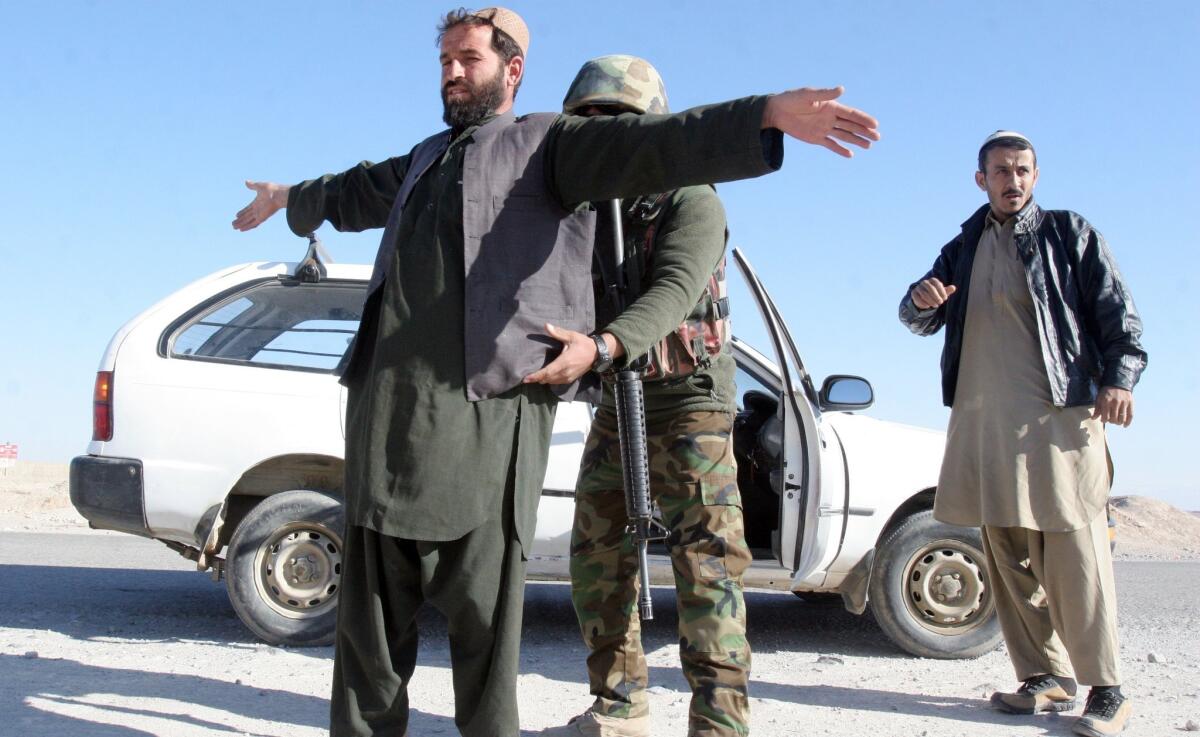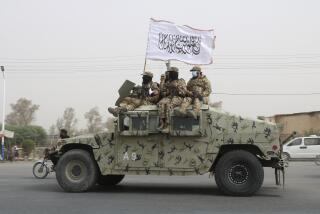What’s behind the Taliban onslaught in Afghanistan?

An Afghan National Army soldier searches a passenger Dec. 23 at a checkpoint on the way to the Sangin district of Helmand province, Afghanistan.
- Share via
Reporting from Kabul, Afghanistan — It’s starting to look like the bad old days in Afghanistan.
After six Americans were killed in a suicide bombing this week, and with the U.S. and Britain deploying troops to help battle a Taliban onslaught in strategic Helmand province, Afghanistan looks as shaky as at any point since U.S.-led international forces withdrew into a smaller, supporting role 12 months ago.
The Taliban have shrugged off internal leadership disputes to score a string of military victories. Meanwhile, President Ashraf Ghani is confronting growing dissent and signs that Afghanistan’s internationally trained security forces cannot hold large stretches of the country without foreign support.
A few months ago, Ghani and U.S. officials were hopeful that Taliban leaders were edging toward peace talks, which nearly everyone agrees is the only way the 14-year conflict will end. With the insurgents gaining momentum, negotiations seem unlikely anytime soon, and even the traditionally optimistic Pentagon says things could get worse in 2016.
Why is the battle in Helmand significant?
Helmand – a transit point for militants, narcotics and weapons between Pakistan and Iran – has been by far the deadliest province for U.S. and British forces in Afghanistan over the past decade. Sangin district, where 50,000 residents have been trapped by heavy fighting in recent days, is a hotbed of opium production, a key source of revenue for the insurgents.
In 2010, after British troops pulled out, Marines from the 3rd Battalion, 5th Regiment, based at Camp Pendleton, began a seven-month tour in Sangin that saw 24 men killed and more than 175 wounded – one of the deadliest deployments of the U.S. war.
Nineteen months after the last Marine unit left Sangin, the district is on the verge of falling back to the Taliban. The insurgents have steadily grabbed control of nearly half the districts in Helmand since this summer and are fighting Afghan forces for several more.
“A Taliban takeover of Helmand would be a huge blow to [U.S. and British] efforts and their egos,” said Orzala Ashraf Nemat, a Kabul-based academic. “They will go to great lengths to keep it in government hands.”
How are the U.S. and allies responding?
The U.S. military has launched airstrikes and deployed an undisclosed number of Special Operations troops to Helmand. This week Britain sent 10 advisors to the provincial capital, Lashkar Gah, to assist Afghan forces.
The expanded operations have come after President Obama announced in October that 9,800 American troops will remain in Afghanistan through the end of 2016. That likely means more U.S. airstrikes and even ground combat – both of which risk dragging American forces back to the forefront of the conflict.
In October, after the Taliban briefly seized the northern city of Kunduz, 42 civilians were killed when a U.S. airstrike hit a Doctors Without Borders hospital. (A Pentagon investigation blamed “human error.”)
On Monday, six U.S. service members on patrol near Bagram Air Base in northern Afghanistan were killed by a Taliban suicide bomber on a motorcycle. U.S. officials identified the Air Force casualties as Maj. Adrianna M. Vorderbruggen, 36, of Plymouth, Minn.; Staff Sgt. Michael A. Cinco, 28, of Mercedes, Texas; Staff Sgt. Peter W. Taub, 30, of Philadelphia; Staff Sgt. Chester J. McBride, 30, of Statesboro, Ga.; Technical Sgt. Joseph G. Lemm, 45, of New York City; and Staff Sgt. Louis M. Bonacasa, 31, of Coram, N.Y.
The deeper U.S. involvement bolsters Taliban propaganda that they are fighting a foreign occupier. During the 15-day battle for Kunduz, residents complained that airstrikes leveled civilian areas and put locals in harm’s way.
Even if the Afghan soldiers rushing to Helmand retake parts of the province, the Taliban, with a seemingly inexhaustible bench of fighters, has stretched the limits of local and U.S. forces.
“The Taliban strategy seems to be trying to wear the Afghan government forces out, with the assessment that there’s only a limited number of units with good fighting capability,” said Thomas Ruttig, cofounder of the Afghanistan Analysts Network, a Kabul-based research group.
What’s wrong with the Afghan government?
The Taliban’s gains are a symptom of what analysts describe as leadership failures by Ghani’s administration.
The unity government brokered by Secretary of State John F. Kerry after last year’s disputed election has made almost no one happy. Key government posts, including the minister of defense, have not been permanently filled. The security forces remain plagued by poor logistics and unknown numbers of “ghost soldiers” – troops who exist only on paper so military officers can collect their salaries, Ruttig said.
Ghani’s biggest political gamble – trying to persuade Pakistan to help launch peace talks with Taliban leaders based on its soil – has so far failed. Record numbers of Afghans are choosing to seek asylum abroad rather than live with a spiraling economy and ongoing violence.
“When the Taliban sees they’re making military progress, they’re not inclined to go and negotiate,” Ruttig said. “That means more fighting and more harm to the civilian population.”
What do military advances say about the Taliban’s cohesion?
After announcing in July that its longtime spiritual leader, Mullah Muhammad Omar, had been dead for two years, the Taliban saw a nasty internal fight over his successor.
Some commanders defected and pledged allegiance to Islamic State. Others tried to dislodge the new leader, Mullah Akhtar Mansour, who was reportedly injured when an argument broke out at a meeting this month.
Yet battlefield successes have allowed the Taliban to paper over the cracks, helped by a young generation of Afghan fighters trained at camps across the border in Pakistan.
“It is an organization that lacks a political leader and a political agenda, but because of the support and mentorship they received from the outside, they have increased military capability,” said Davood Muradian, founding director of the Afghan Institute for Strategic Studies, a Kabul think tank. “Right now the Taliban might be politically fragmented, but militarily they are more powerful.”
Latifi is a special correspondent. Times staff writer Bengali reported from Mumbai, India.
More to Read
Sign up for Essential California
The most important California stories and recommendations in your inbox every morning.
You may occasionally receive promotional content from the Los Angeles Times.










